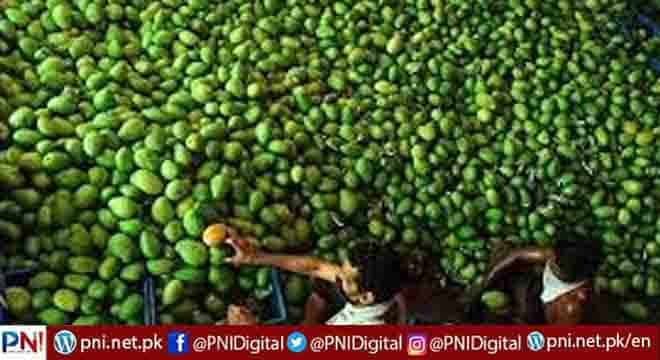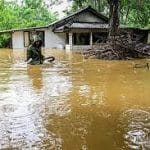By Jehangir Khan Tareen
MULTAN, Jun 07 (APP): Pakistan is a land blessed with four seasons but this year we directly landed from winter into summer without having spring and its allied charms. The shift was abrupt and traumatically shocking, especially in South Punjab which is mostly agrarian belt and food basket of the country.
Scientifically considered as King of Fruits, Mango is the leading fruit crop of Pakistan after Citrus mainly grown in Punjab and Sindh over an area of 99 thousand tons hectares with an annual production of 1322 thousand tons according to Ministry of Ministry of National Food Security and Research data of 2021.
In Punjab, average yield is 13.33 tons per hectare whereas it is 5.57 tons per hectare in Sindh. Population wise the largest province in the country, Punjab is contributing 77 percent of fruit while Sindh produces 23 pc.
Mango can be grown in a diversified climate; however, the range of suitable temperature for successful crop production is from 6C to 42C.The temperature beyond this limit may affect plant health and performance. The changing climatic patterns are being observed in recent years which are impacting the crop significantly.
Pakistan is facing unexpected drought periods, heat waves, frost spells, hail, wind storms, rains, floods, fog, smog etc. under climate change scenarios.
Deputy Director Task Force Agriculture South Punjab, Asif Raza informed that flowers of the “king of fruits”, shed heavily in March this year as it needed low temperature for it to bloom in this season while it rose above the normal range. “We are expecting a low yield of mango this year,” he apprehended.
He informed that during the past years, it was noticed that heat wave in April and May damaged the fruit and affected its quality resulting in burning (black spots) at Safaid Chaunsa facing Sun , splitting and fruit curve in Sindhri, de-shaping of Chaunsa, Dusehri and Anwar Retaul. The heat wave reduced the fruit size in all varieties.
Terming the heat wave a natural phenomenon, a progressive grower Jehanzaid Dharala said that the last heat wave on record was in 1962 adding that after 60 years it has once again occurred.
“Normally, in March, the temperature is between 26-32 C, but this year, it has 44C which is 12 degree centigrade above the normal which made the pollen dead and female flower of mango rusted. Around March 20 hot winds burnt the canopy of the tree too. Resultantly, we have lost up to 65 pc mango in Multan and Khanewal districts.
Kashif Qadeer Khan, a farmer from Dera Ghazi Khan is still struggling to come out of the dejection mode since the day the cotton plants he had sown on 17.5 acres land wilted due to heat wave amid acute water shortage. And this he suffered after all he had earned from heat wave-hit wheat crop invested in cotton.
“Last season, I got a yield of 44 maunds per acre but it reduced to 28 maunds per acre in 2022 after the sudden heat wave shortened the size and reduced weight of the grain by triggering premature maturity.”
Kashif said he was not the only farmer to have suffered the financial blow due to the heat wave “I invested the resources on sowing cotton in hope of making up for losses but all I got was wilted plants, ” he lamented..
The high temperatures combined with other conditions such as relative humidity give rise to heat waves that can claim lives of thousands of people destroy crops and damage infrastructure.
The Intergovernmental Panel and Climate Change Sixth Assessment Report said that heat waves and humid heat stress will be more intense and frequent in South Asia in this century.
Director Regional Meteorological Centre (RMC) Lahore, Aslam Chuadhary said that nothing was sudden in this universe even the chances of a dust storm are predicted two or three days before it.
Heat wave is a global phenomenon and South Asia is facing it these days, he said, adding that the RMC had compiled data of normal parameters of Punjab Stations for 30 years from 1980-2010 while it was under process by 2020 which is expected to be accomplished within the next five to six months.
The data shows that in May average normal max temp of Lahore was 38.8 C, Faisalabad was 39.1 C, Multan was 41 C, Bahawalpur was 41.3 C, and Khanpur was 42 C from 1980-2010.
Human beings are no exceptions and also fall prey to harsh weather conditions especially those whose immunity is weak or are suffering from different diseases.
Senior Medical Officer Govt Shehbaz Sharif Hospital, Dr Imran Rafiq informed that heat related disorders occur when extreme environmental conditions affect people who are physically active in extreme ages or with chronic medical or psychiatric illness.
Heat exhaustion results from prolonged strenuous activity with inadequate water or salt intake in a hot environment, the medic noted. He maintained that heat stroke, the hallmark of which is cerebral dysfunction and body temperature over 40C, is a life-threatening emergency whose symptoms include: dizziness, weakness, blurred vision, confusion, collapse and unconsciousness.
Public education is imperative to improve prevention and early recognition of heat wave illness and individuals should take steps to reduce personal risk factors and to acclimatize exposure to hot weather conditions, he suggested.
The Cholistan Desert, popularly known as “Rohi” consists of Bahawalpur, Rahim Yar Khan and Bahawalnagar districts has been hit hard owing to heat waves and several cattle heads died of shortage of water according to media reports. However, Rolilas heaved a sigh of relief due to recent rain in their area.
Managing Director Cholistan Development Authority (CDA), Mehr Khalid Ahmed said that it was mainly a rain-fed area and dwellers depend on its water which they collect in “ Kund”, an underground reservoir to run their daily affairs.
He informed that the local population along with their cattle heads moved to settled areas for a month or so if it does not rain in the desert and returned after the rain. He rebutted media reports about death of a large number of animals in Cholistan due to water crunch as a result of heat wave adding that only 26 sheep fell victim to dehydration which was the mistake of the shepherd who had not shown water to animals for a day.
“We have around 1.3 million livestock in Cholistan. If it was affected by heat waves or dearth of water, news of their deaths on a daily basis appeared in papers. Only 26 sheep of the family had not died so far.” CDA MD maintained.
A spokesperson for P& SHC dept South Punjab, Assad Ullah Shazad informed that 42 heat stroke counters have been set up at DHQs and THQs across the region which included 8 at District Headquarter Hospitals and 34 at Tehsil Headquarter Hospitals in wake of heat waves.
Follow the PNI Facebook page for the latest news and updates.







